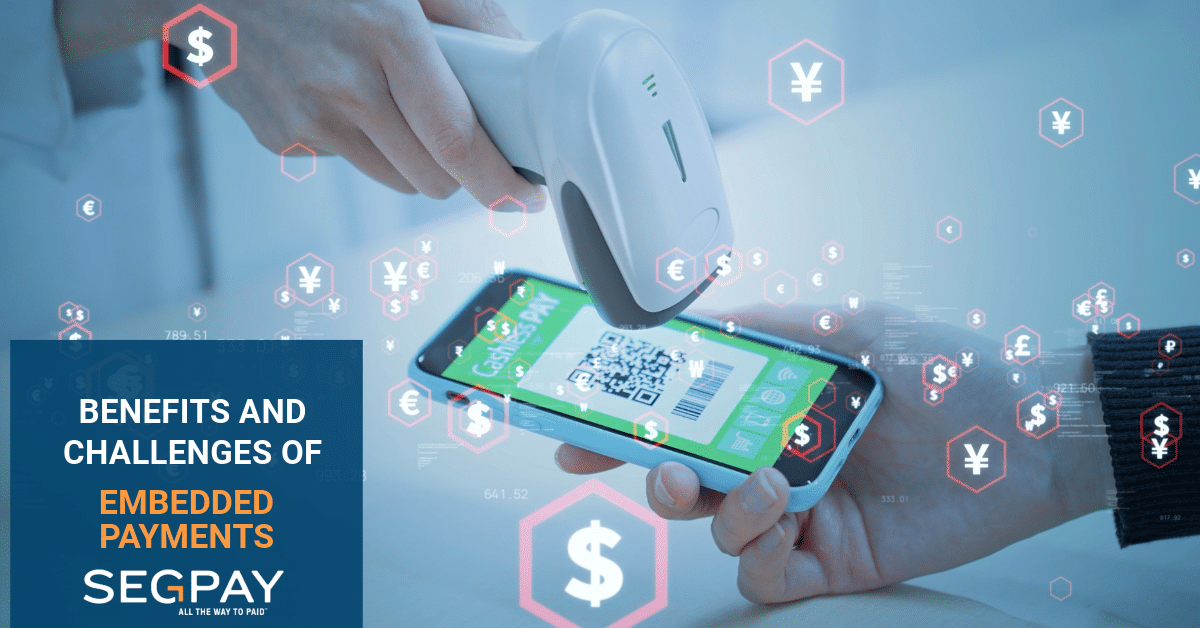Key Takeaways
√ Embedded payments benefit digital and e-commerce businesses by increasing conversion rates, improved customer experiences, and opportunities for new revenue sources.
√ Businesses can leverage data collected from embedded payments for valuable data insights and analytics to identify new target markets and opportunities to cross-sell or upsell services or products to users.
√ A custom-embedded payment solution from a third-party payment processor provides the benefits of embedded payments without the capital outlay or risks inherent in such payments.
- 7 minute read
In today’s digital business world, speed and convenience are the name of the game. Within the financial transactions arena, embedded payments are the latest game changer. Embedded payments revolutionize how businesses handle financial transactions, providing customers and merchants with a more streamlined and user-friendly payment experience. Additionally, embedded payments can help companies to unlock future sources of revenues.
What are Embedded Payments?
Embedded payments are part of a more significant fintech industry, embedded finance. Consumer payments are more than 60% of embedded finance transactions. Embedded payments, meaning in-app or integrated payments, are the seamless payment processing integration with an in-application or a digital platform.
Unlike traditional payment methods, which often require users to navigate to a separate payment gateway or manually input their payment information, embedded payments are designed to occur seamlessly as a button or click within the app or digital platform the consumer uses.
Real-life embedded payments examples include the following:
- E-commerce Platforms: Online retailers can seamlessly integrate payment processing into their websites, making it easy for customers to purchase without being redirected to external payment gateways.
- IoT Devices: IOT devices, like smart vending machines or connected appliances, use embedded payments to facilitate transactions.
- Mobile Apps: Mobile applications like Uber and Doordash can benefit from embedded payments for in-app purchases, subscriptions, and mobile commerce, creating a hassle-free buying experience for users.
- Online Marketplaces: Online marketplaces can facilitate secure and efficient transactions between buyers and sellers by integrating payment processing directly into their platforms.
- SaaS Providers: Subscription-based software providers and streaming service operators can automate recurring billing and subscription management, reducing churn and improving revenue predictability.
Two Methods of Embedded Payments
In-House Embedded Payments
In-house embedded payments refer to developing and managing your payment infrastructure entirely within your business.
PROS:
- Freedom to tailor the payment process to your brand and needs.
- Direct control over your user’s financial data.
- Systems can adapt quickly to business changes.
- Businesses can scale the payment system independent of third-party constraints to their needs and customer base.
CONS:
- Your business will build, maintain, and secure the entire payment process.
- Initial development and regular maintenance costs can require significant capital.
- The Learning curve for laws and regulations regarding payments and data protection can be steep.
Third-Party Facilitated Embedded Payments
Third-party facilitated embedded payments involve a partnership between a business and a third-party payment facilitator or processor.
PROS:
- There is no initial capital building, maintaining, or securing the payment process because the third-party provider handles everything.
- Third-party embedded payment solutions are faster to implement.
- Third-party payment facilitators are experienced in fraud prevention, compliance, and risk mitigation,
- Third-party payment facilitators accept a wide variety of payments and currencies, making it easier to reach a global customer base.
CONS:
- Less direct control over the payment system
- Business changes may require the input of the third-party payment facilitator.
Learn more about embedded payment solutions.
How do Embedded Payments Work?
Embedded Payment systems can be In-House or Third-Party Facilitated.
In-House Embedded Payments
In-house embedded payments work by leveraging Application Programming Interfaces (APIs) and payment gateways to seamlessly integrate payment processing into various applications and digital environments.
- Businesses integrate payment APIs into their digital platforms, applications, or websites. These APIs link directly to a payment gateway or processor, enabling secure and efficient transactions.
- Users can make payments without being redirected to external pages or having to re-enter their payment information.
- For security purposes, user authentication is often required to complete a payment.
- Once the payment details are authenticated, the payment processor handles the transaction, ensuring that funds are transferred from the customer’s account to the merchant’s account.
- Users receive immediate confirmation of their payment and a digital receipt, ensuring transparency and accountability in the transaction.
Third-Party Facilitated Embedded Payments
Third-party facilitated embedded payments involve external payment providers to manage the payment processing.
- The payment companies provide the APIs and integration assistance to integrate payments into your application or site.
- Users can still make payments without being redirected to external pages or having to re-enter their payment information.
- The third-party provider handles security, authentication, maintenance, updates, and compliance.
- The third-party provider transfers funds from the customer’s account to the merchant’s.
Benefits of Embedded Payments for the Consumer
- Convenience: Embedded payments make the checkout process quicker and more convenient. Consumers don’t have to leave the app or website to complete a payment, which reduces friction and saves time.
- Enhanced Security: 19% of online shoppers leave an e-commerce site because they didn’t trust the site with their credit card information. Embedded payment solutions require advanced security measures, like encryption and fraud detection, to protect customer data and transactions. This enhanced security reduces the risk of data breaches and builds user rust.
- Enhanced User Experience: When you remove all the redirections of an external gateway, you reduce the steps required to complete the transaction and get a simple, user-friendly payment experience that has been proven to increase conversion rates and customer loyalty.
- Faster Checkouts: With embedded payments, the entire transaction happens within the platform, and the checkout process is quicker and more efficient. Customers can complete transactions faster. No waiting and no hassle.
Benefits of Embedded Payments for the Business
1.Increased Conversion Rates
According to the Baymard Institute, 18% of online shoppers abandon their cart due to the complicated checkout process. With payment information already stored within the app, website, or digital platform, consumers can complete transactions faster without hassle.
2. Streamlined Operations
Embedded payments help businesses streamline operations by integrating payment data into their systems. This process simplifies accounting, reporting, and reconciliation processes.
3. Access to Valuable Data Insights: Embedded payment solutions often provide access to data analytics and insights that can help businesses better understand patterns of customer behavior, purchases, and preferences.
Such data insights can be used for better-informed marketing, product design, and pricing. Additionally, data can be leveraged to personalize the user experiences and customize product and service recommendations.
4. Opportunities for Cross-Selling
Embedded payment platforms can integrate cross-selling and upselling opportunities, allowing businesses to offer complementary products or services during checkout.
5. Enhanced Security and Fraud Protection
Businesses benefit from the enhanced security features of embedded payments, which help reduce the risk of fraud and data breaches.
6. Support for Scaling Globally
Many embedded payment solutions support multiple currencies and payment methods. Such support allows businesses to expand into international markets.
The Challenges of Embedded Payments
- The Complexity of Integration: Implementing embedded payments can be technically complex, requiring businesses to invest in technology and personnel to ensure a seamless user experience.
- Security: While embedded payments can enhance security, they are not immune to cyber threats. Businesses may be required to make significant investments in encryption and anti-fraud technology to protect customer data.
- Regulatory Compliance: Besides the laws and regulations inherent in the product or service the business sells, businesses must also navigate a complex landscape of regulations and compliance requirements regarding financial payment processing.
Businesses can improve revenue streams and customer experience with embedded payments. To succeed, choose your embedded payment partner carefully.
Why Choose Segpay as Your Embedded Payments Partner?
>As a Payment Facilitator, Segpay handles the onboarding and provides a fully managed payment processing solution.
>Segpay is a global payment facilitator specializing in payment processing for e-commerce and SaaS.
>Segpay is a level 1 PCI service provider with technical resources to ensure the strongest security measures for our clients worldwide.
>High-Level Fraud Prevention and Risk Management
>Unmatched customer service and support
Want to learn more about embedded payments?
Contact us today. Let Segpay contribute to your business’s success and growth in the digital era. Let’s talk.
Reach out to us with your questions at [email protected]



